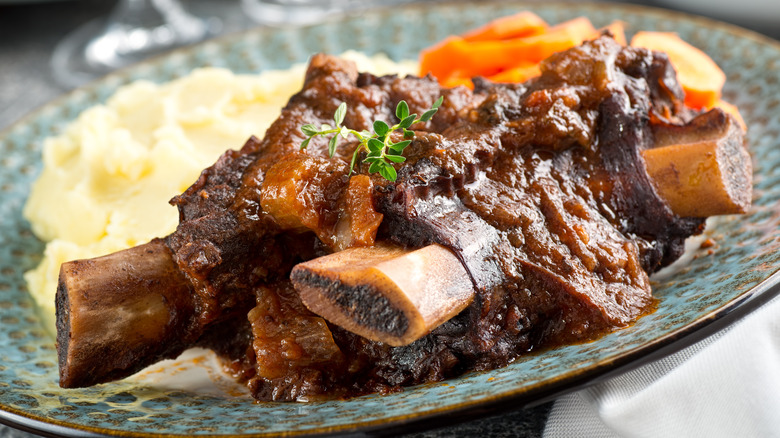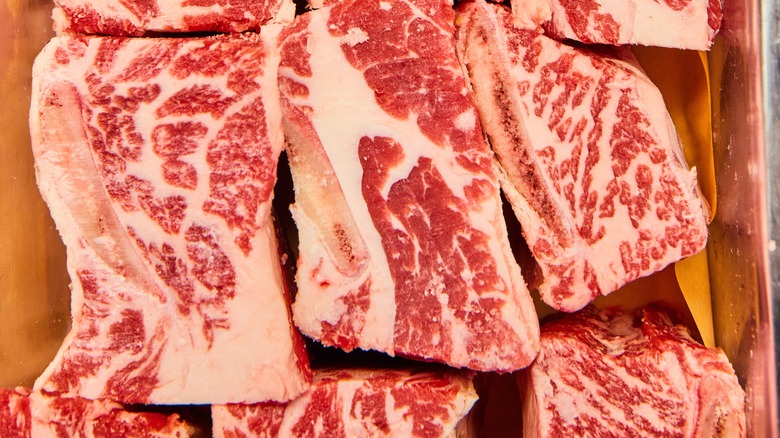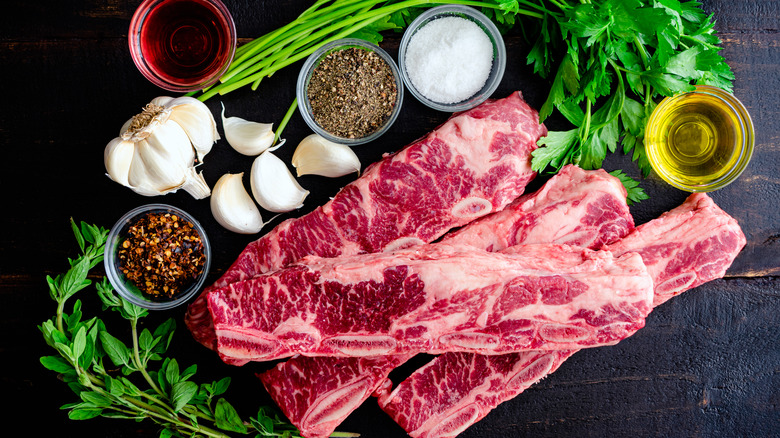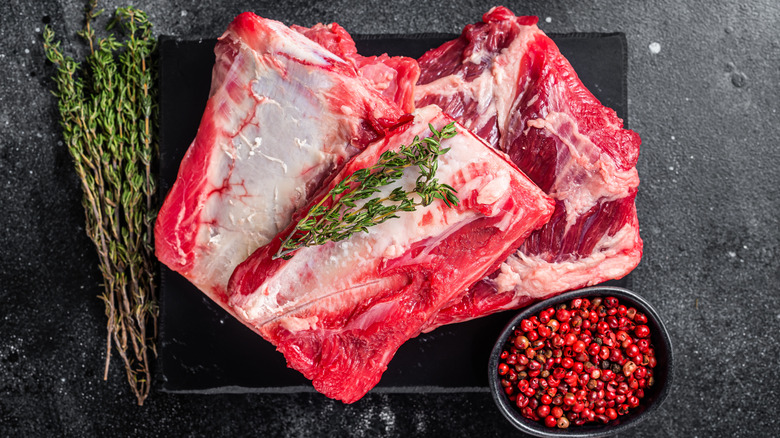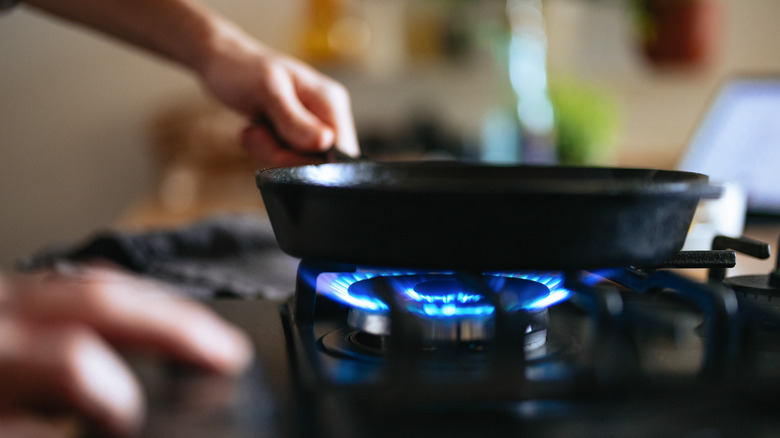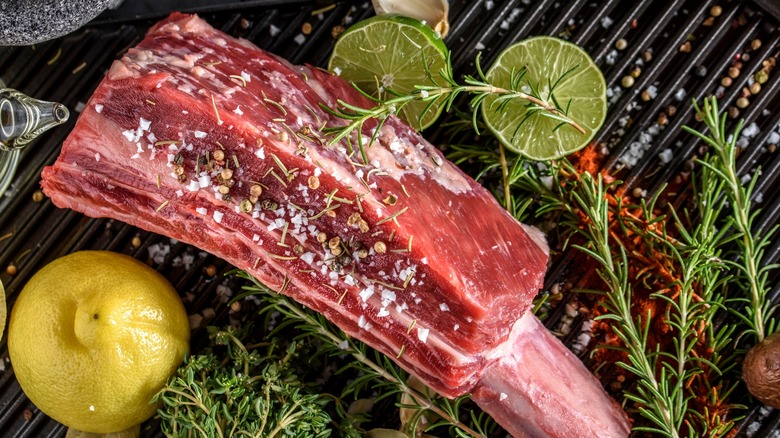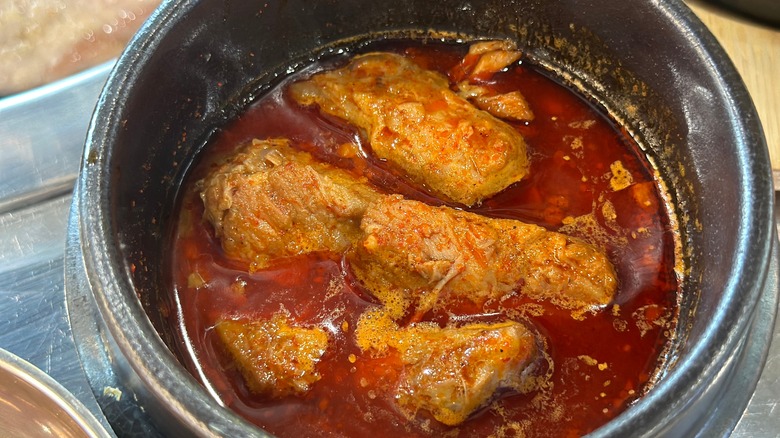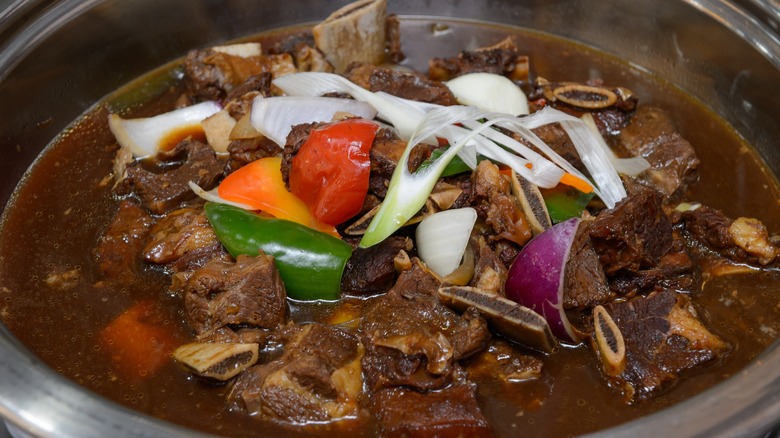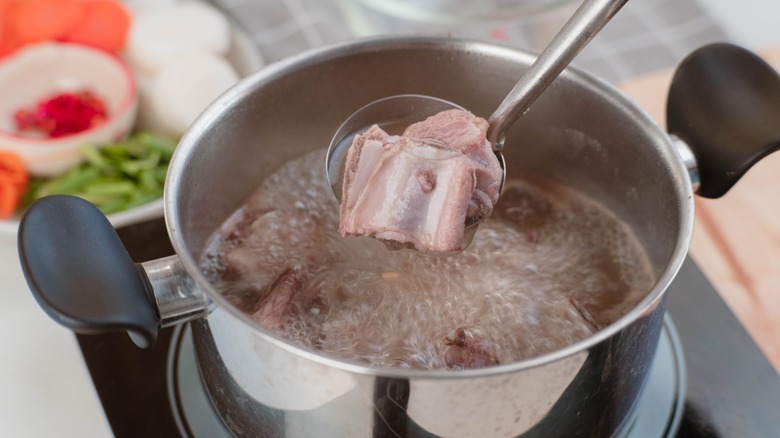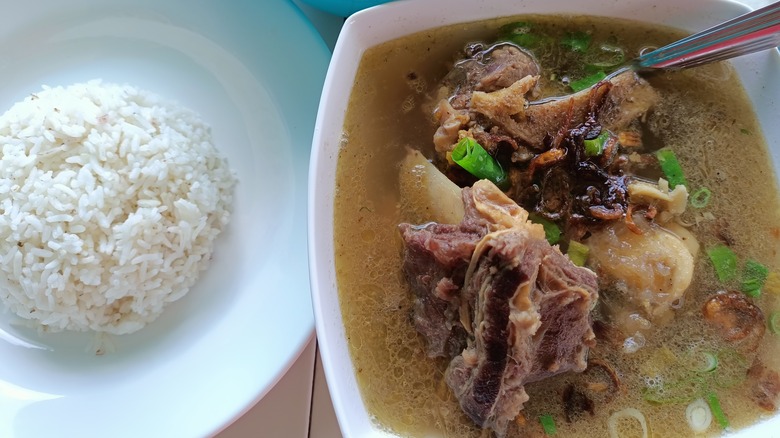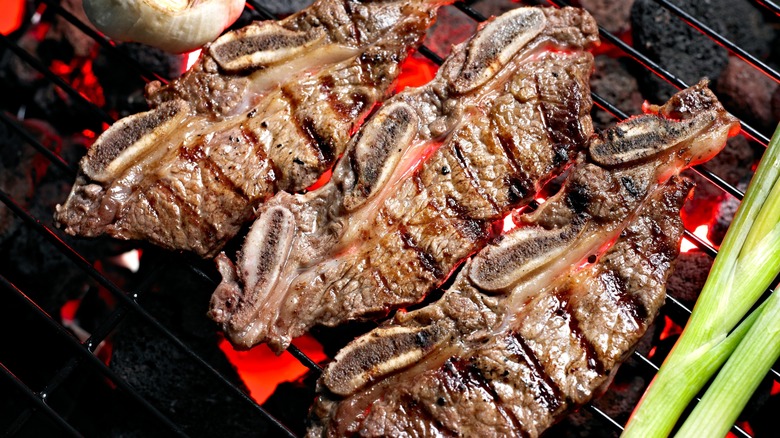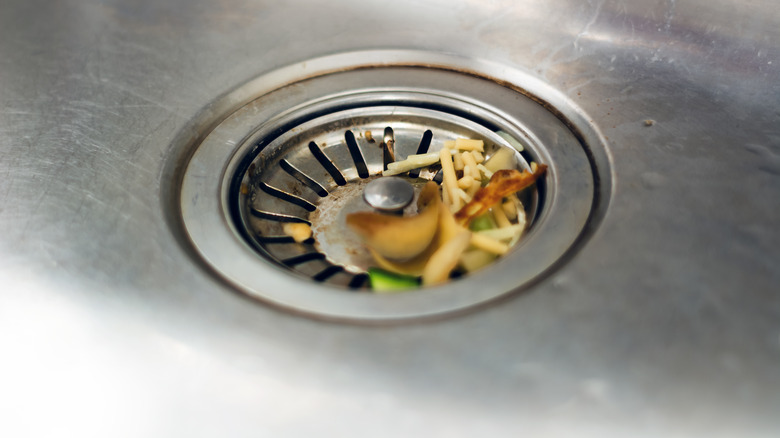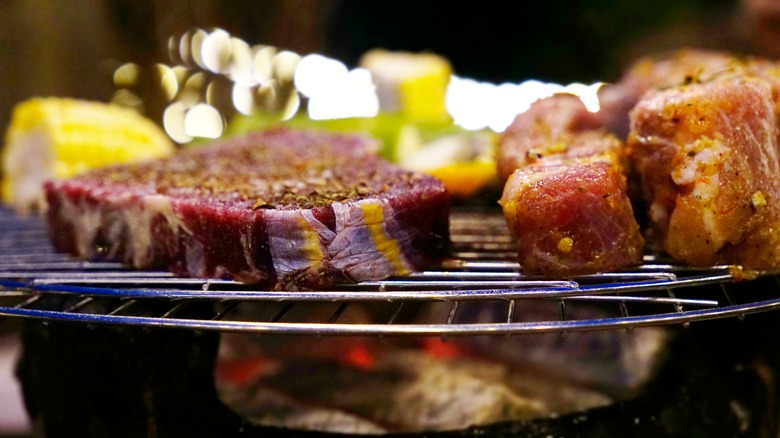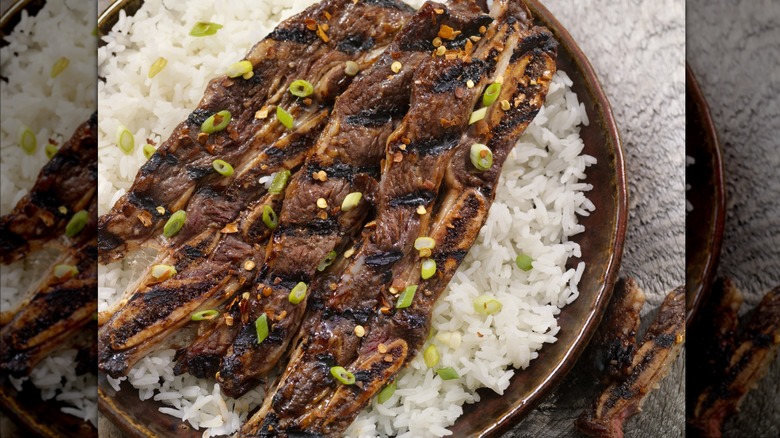Mistakes Everyone Makes When Cooking Short Ribs As Explained By Chefs
We may receive a commission on purchases made from links.
Short ribs are one of those dishes that has the potential to turn out amazing. When cooked right, the ribs have the perfect combination of tenderness and flavor, and they simply melt in your mouth. However, in the same way many people are plagued by mistakes when cooking ground beef, several also make missteps when preparing short ribs.
To help you ensure your short ribs turn out properly, we reached out to two experts to help guide your short rib cooking experience. George Duran is a celebrity chef, comedian, and entertainer and Jessie-Sierra Ross is a TV food content creator on NBC, CBS, and PBS, a cookbook author of Seasons Around the Table, and a food & lifestyle blogger at Straight to the Hips, Baby. Duran and Ross helped us understand some of the more common mistakes people make when preparing short ribs and what you should do instead.
Not understanding the difference between short rib cuts
Just as there are different types of pork ribs, there are also different types of beef ribs. Understanding how these cuts differ can help ensure you make the best choice for the recipe you are preparing. Jessie-Sierra Ross explains, "Short ribs are best for low and slow cooking, braising, or smoking techniques." By contrast, Ross explains that back ribs come from the area in the upper rib area. They are leaner than short ribs which come from the lower rib section, which means you'd have to add more fat if you wanted to use them in a recipe for short ribs.
There are two main types of short ribs: plate short ribs and chuck short ribs. Plate short ribs, which you're most likely to find at the store, come from under the brisket section of the chest. These have a higher fat content, which can help prevent them from getting overly dry as they cook. Chuck short ribs, which come from the shoulder region, are a bit tougher and have more connective tissue. They'll taste best when slow-cooked to help the meat get nice and tender.
Not knowing the difference between short rib cutting styles
In addition to the two main types of short ribs, there are also two different cutting styles. English short ribs are cut between the bones. Each rib has a large piece of meat on top of it. English short ribs are ideal for slow cooking, barbecuing, and more. Flanken ribs, on the other hand, are often used for Korean barbecue and other similar preparation styles. These ribs are cut very thin, but in such a way that there are small pieces of bones from multiple ribs intertwined with the meat and fat.
George Duran stresses the importance of fat as well when choosing short ribs. He says, "Short ribs need a good amount of fat and connective tissue to become tender and flavorful when cooked." He advises you to "choose well-marbled cuts with visible fat [because] the fat and collagen will break down during cooking, making the ribs moist and succulent."
Not buying enough meat
Is there anything worse than making a recipe and realizing too late that you don't have enough to serve the number of people coming for dinner? When tender and delicious short ribs are your recipe's headlining act, you certainly don't want to find yourself in a position where you are ... ahem ... short a few ribs. Jessie-Sierra Ross explains that "some ribs will be perfect, and some ribs will be downright smushy with fat marbling." This is due to the inconsistent distribution of fat between the short ribs. While you want some fat for cooking, an excessive amount won't taste good, so you're better off throwing away these ribs.
If you started with just enough ribs for the recipe, you won't have enough to feed everyone if you throw a few out. To avoid this potentially disastrous problem, Ross says, "I always buy a little extra just in case, to make sure I can create enough proper portions. Don't be caught short — buy an extra rib!"
Forgetting to sear the ribs before braising
When you've cooked short ribs in the past, did you sear them before braising? If not, you've been making a serious short rib preparation mistake. Chef George Duran explains why ribs that aren't seared will lack flavor. He says, "Searing the ribs before braising helps to develop a rich, deep flavor through the Maillard reaction, which creates a savory crust on the meat."
So, the next time you prepare short ribs, leave yourself a few additional minutes to sear them. Chef Duran says, "Before braising, heat a little oil (neutral oil works best) in a heavy skillet or Dutch oven until it's shimmering hot. Sear the ribs on all sides until they are browned and caramelized, then proceed with braising." For a true test of the difference this step makes, consider preparing two batches of short ribs — one without searing and one with — then compare the finished results. We bet you won't make the mistake of forgetting to sear the ribs again after tasting the difference.
Not seasoning the ribs properly
Seasoning is important for hot dogs, pork chops, chicken breasts, and yes, even short ribs. Chef George Duran explains that without seasoning, the full flavor of the ribs won't come out. However, seasoning ribs is a bit of an art. "Under-seasoning can lead to bland meat, while over-seasoning can overpower the natural taste," shares Duran.
Before cooking, be sure to add a generous amount of salt and pepper to the ribs to enhance their flavor as they cook. Duran also says to "taste the braising liquid as it cooks and adjust the seasoning as necessary to ensure a balanced, flavorful dish." If you wait until you are ready to serve, it will be too late to make any meaningful changes to the flavor of the ribs or the braising liquid.
While sticking to salt and pepper is usually enough to bring out the ribs' natural flavor, you can get more adventurous. Why not try a red wine braising? Or, if you're interested in unlocking a tropical nuance, try a coconut braise on your short ribs.
Not choosing the best braising liquid
One of the most popular ways to prepare short ribs is by braising them in liquid. According to Jessie-Sierra Ross, one of the most common mistakes people make is choosing the wrong liquid for braising. She explains that the braising liquid you choose is "your chance to add flavor to the dish! The braising liquid helps infuse the meat, and helps to break down the fat and collagen of the ribs." Make the wrong choice, and your dish could be lacking in flavor.
Ross shares that beef broth combined with red wine makes an excellent braising liquid. So, instead of freezing your leftover wine, you could even put it to good use when preparing a short rib recipe. Alternatively, Ross explains, "using beer instead of red wine is also a great option, as is adding a tablespoon or two of tomato paste and Worcestershire sauce, for some extra umami flavor."
Not adding enough liquid when braising
"Braising relies on a slow, moist cooking environment. If there isn't enough liquid, the meat can dry out, and the cooking process will be uneven, potentially leading to tough, chewy ribs," says George Duran. Can you imagine how disappointed your guests would be if you promised moist and tender ribs, but they end up dry and chewy ones?
To avoid this catastrophic mistake, you must make sure that you are using enough liquid. According to Duran, the braising liquid should come a minimum of halfway up the sides of the short ribs. He notes, "This helps maintain moisture and allows the meat to cook slowly and evenly, resulting in tender, flavorful ribs." Duran also suggests erring on the side of caution and adding a little more liquid than you think you need, to prevent the dreaded chewy rib. A little extra liquid will ensure the ribs turn out moist and juicy.
Allowing the liquid to come to a full boil
While you want to ensure that the braising liquid is hot enough to cook the short ribs, you should keep it from coming to a full boil. Chef George Duran highlights several reasons why you mustn't let the braising liquid get so hot that it starts boiling. He explains that boiling the meat may cause it to dry out instead of ensuring it turns out moist and tender. Moreover, he says, "High heat can also break down the braising liquid too quickly, leading to reduced sauce and potential burning of what you're braising."
Instead, you want to warm the liquid to a simmer, then turn the burner down to low. This will keep the liquid warm and simmering but prevent it from boiling and causing the issues mentioned above. Remember, as Duran points out, "The key to tender short ribs is low and slow cooking, which breaks down the connective tissues without drying out the meat." He adds, "This dish is ALL about patience!"
Not skimming the fat
The fat from short ribs is part of what makes them so tender and flavorful. However; their higher fat content can also be a downside if proper precautions aren't taken. According to Chef George Duran, "braised short ribs can release a lot of fat into the braising liquid making the final dish greasy and overly rich." A simple fix to combat this potential problem is to skim the fat periodically.
Skimming the fat is a relatively simple task. Just take a large spoon and run it across the very top layer of the liquid to remove the accumulated fat across the pot. Alternatively, Chef Duran says, "You can also let the dish cool, then refrigerate it so the fat solidifies on top and can be easily removed before reheating and serving." The best method will vary depending on how and when you plan on serving and eating the ribs.
Cooking at too high a temperature
Just as the high heat of a grill isn't good for brisket, you must also be careful to avoid cooking short ribs at too high of a temperature. Chef George Duran explains, "High temperatures can lead to tough, overcooked meat and a reduction of the braising liquid, potentially causing it to burn or concentrate too much."
According to Chef Duran, short ribs turn out best when cooked at a very low setting. He recommends setting the oven or slow cooker to about 300 degrees Fahrenheit for the best results. "This ensures the meat becomes tender without drying out or over-reducing the sauce." Using a slow cooker is a popular choice when making short ribs. These small kitchen appliances are designed for low and slow cooking and are ideal for short ribs. Just remember to take appropriate precautions if you're leaving your slow cooker on overnight or when you're away from the house.
Dumping leftover braising liquid
"Don't dump that liquid gold," exclaims Jessie-Sierra Ross referring to the braising liquid. Once the ribs have finished cooking, she explains that the drippings and fat from the short ribs turn the braising liquid into a delicious sauce that you can serve alongside the meat as a gravy. However, you'll need to take a few quick steps you'll need to convert the sauce into a thicker gravy.
After removing the ribs from the liquid, Ross says, "Bring the pot to a low boil uncovered and reduce the braising liquid by ⅓. In a separate bowl, make a slurry of cornstarch and cooking liquid." Then, whisk the slurry mixture in with the braising liquid over medium-low heat until you're left with a thick gravy. As Ross says, "The cooking liquid has now become a delicious sauce for the ribs!"
Under (or over) cooking the ribs
"Nothing is more disappointing than biting into an overcooked piece of short rib! Dry, stringy, and flavorless," laments Jessie-Sierra Ross. Once your short ribs are overcooked, there's no going back, unless you have a time machine hiding in your kitchen. Just as a meat thermometer can come in handy when frying food, it should also be ready when cooking short ribs to ensure you don't cook them to the point that they dry out. "This isn't a steak — look for a finished cooking temperature of about 200 degrees Fahrenheit to 205 degrees Fahrenheit. The meat will be rendered, and falling off the bone, but not stringy," shares Ross. If you accidentally overcook the ribs, Ross recommends serving them with sauce or gravy to cancel out some of the dryness.
You don't want to serve your guests overcooked ribs, but you also don't want to serve ribs that aren't fully cooked, which could potentially give your guests food poisoning. Again, use the meat thermometer to check for doneness before removing the ribs from the oven or braising liquid. If they haven't hit that 200 degrees Fahrenheit temperature, return them back so they can continue cooking a bit longer.
Not experimenting with different cooking methods
Once you've successfully cooked short ribs a few times using one method, it is time to branch out. As Chef George Duran explains, "Sticking to only one method of cooking short ribs can limit the range of flavors and textures you experience. Different methods can bring out different qualities in the meat."
Fortunately, there are many ways to cook short ribs for delicious results. A few options include using a pressure cooker, cooking the ribs in a slow cooker, grilling them, smoking them, or baking them in the oven. "Each method offers unique results — grilling can add a smoky char, while sous vide can ensure perfect doneness and tenderness," says Duran. Using a pressure cooker is Duran's favorite way to prepare short ribs. "You can cook short ribs to tender perfection in ⅓ of the time needed to braise it. It's my go-to method 100%," he says.
